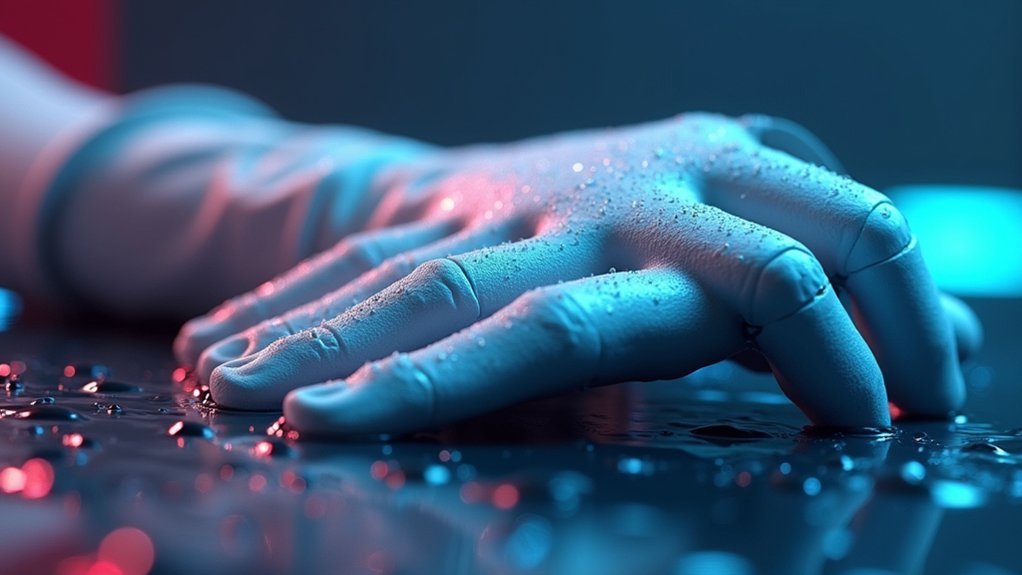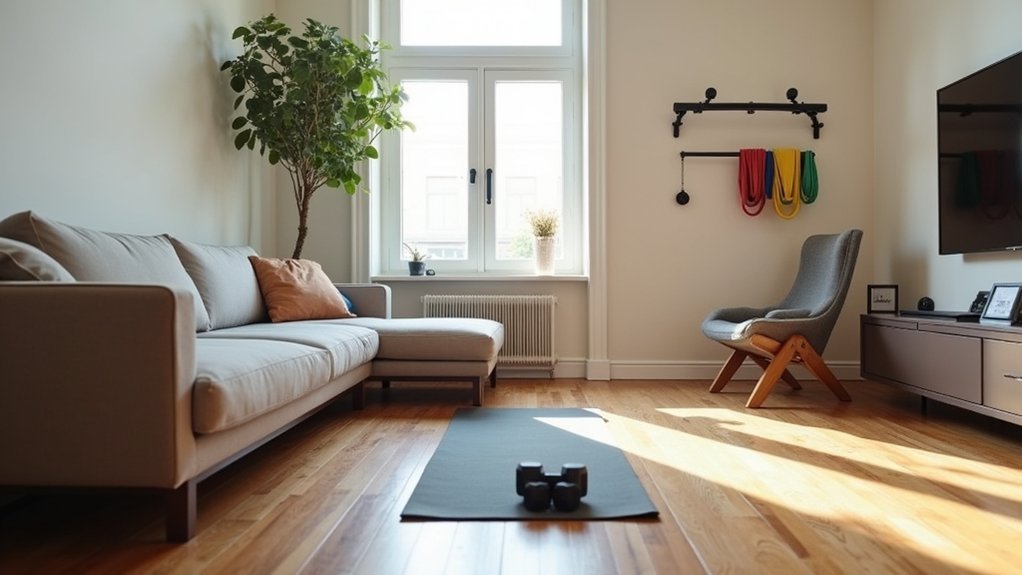VR gloves achieve water-repellency through advanced hydrophobic nanotechnology coatings that create molecular barriers, causing water to bead up and roll off instantly. You’ll find they’re constructed with water-resistant materials like Gore-Tex, featuring sealed seams and waterproof zippers that protect sensitive electronics while maintaining flexibility. The manufacturing process integrates moisture-wicking liners and breathable fabrics to manage sweat during extended sessions. These sophisticated engineering techniques work together to guarantee your gloves stay completely functional even when exposed to moisture, and there’s much more fascinating technology behind their impressive protective capabilities.
Hydrophobic Coating Technology in VR Gloves

When you’re immersed in an intense VR gaming session, the last thing you want is moisture compromising your equipment’s performance. Hydrophobic coating technology in VR gloves creates a molecular barrier that repels water completely.
This advanced material reduces surface tension, causing water droplets to bead up and roll off rather than penetrating the glove’s surface.
You’ll benefit from enhanced durability since moisture can’t damage the internal components. The coating maintains effectiveness even after multiple washes, ensuring long-lasting protection.
Enhanced durability protects internal components from moisture damage while maintaining coating effectiveness through multiple washes for long-lasting protection.
Most importantly, this technology doesn’t compromise your tactile sensitivity or the glove’s flexibility. Whether applied to synthetic or natural fibers, hydrophobic coatings keep your hands dry during extended sessions, maximizing comfort while preserving the precise control you need for immersive VR experiences.
Water-Resistant Materials and Fabric Integration
While hydrophobic coatings provide surface-level protection, integrating water-resistant materials directly into the glove’s fabric structure creates a more thorough defense system.
You’ll find that manufacturers use hydrophobic fabrics like Gore-Tex, which repel water while maintaining breathability for comfort during extended VR sessions.
Advanced manufacturing techniques enable seamless integration of these protective elements:
- Laminated textile layers that bond water-resistant barriers without compromising finger flexibility
- Sealed seams that prevent liquid infiltration at vulnerable connection points
- Waterproof zippers that maintain accessibility while protecting internal electronics
These water-resistant materials work together to enhance moisture resistance throughout the entire glove structure.
You’ll experience consistent haptic feedback even in humid environments, as the integrated fabric protection shields sensitive electronics from water damage while preserving the natural movement your VR applications demand.
Sealed Seam Construction for Electronic Protection

Electronic vulnerability represents the greatest threat to VR glove functionality when moisture penetrates through unsealed joints and connection points. Sealed seam construction addresses this critical weakness by creating impenetrable barriers around sensitive components. You’ll find that waterproof adhesives and heat sealing work together to form robust protection while maintaining flexibility during immersive experiences.
| Construction Method | Protection Level | Durability Factor |
|---|---|---|
| Heat Sealing | High | Extended lifespan |
| Waterproof Adhesives | Maximum | Demanding applications |
| Dual Barrier System | Superior | Wet training scenarios |
| Flexible Joints | Moderate | Standard environments |
This electronic protection guarantees your VR gloves withstand moisture exposure without compromising performance. The sealed construction process maintains comfort while delivering the durability needed for professional training applications where water contact becomes inevitable.
Moisture Management During Extended VR Sessions
Beyond external water protection, your VR gloves must handle the moisture you generate during intense gaming sessions.
Water-repellent materials work alongside sophisticated moisture management systems to keep your hands comfortable during extended play.
Your gloves combat sweat through multiple technologies:
- Breathable fabrics allow rapid sweat evaporation while maintaining water resistance
- Hydrophobic coating repels both external water and internal moisture from reaching electronic components
- Moisture-wicking liners pull sweat away from your skin for faster drying
Advanced ventilation designs promote consistent airflow around your hands, regulating temperature and minimizing perspiration buildup.
These moisture-wicking liners enhance the overall system by creating a barrier between your skin and the glove’s interior.
Together, these features guarantee your VR experience remains comfortable regardless of session length.
Manufacturing Processes for Enhanced Durability

Since water-repellent properties can deteriorate over time without proper manufacturing techniques, the production process for VR gloves requires specialized treatments that guarantee long-lasting durability.
You’ll find that manufacturers apply hydrophobic nanomaterials as coatings, creating protective barriers that repel water while preserving breathability and flexibility. The manufacturing process integrates water-resistant fabrics and utilizes plasma treatment to modify surface properties without compromising haptic feedback quality.
During production, you’ll see reinforced seams and waterproof seals added to enhance moisture resistance.
Quality control measures verify uniform application of water-repellent features, preventing weak spots that could cause performance issues.
These advanced manufacturing techniques create VR gloves that maintain their protective properties throughout extended use, delivering consistent durability for immersive experiences.
Frequently Asked Questions
What Does Water Repellent Mean in Gloves?
Water-repellent means your gloves resist moisture penetration through special coatings that make water bead up and roll off the surface. You’ll stay dry while maintaining grip and dexterity in wet conditions.
How Do VR Gloves Work?
You wear sensors that track your hand movements while haptic motors provide force feedback. You’ll feel virtual objects’ weight and texture through magnetic brakes and vibrations, creating realistic touch sensations.
How Do Haptx Gloves Work?
You’ll experience realistic touch through HaptX’s microfluidic actuators that create 133 feedback points per hand. You’ll feel textures, resistance, and shapes while internal sensors track your precise hand movements for natural virtual interactions.
How Much Do Haptx Gloves Cost?
You’ll pay between $5,000 to $10,000 for HaptX gloves, depending on the model and features. They’re priced for enterprise applications like training simulations, not consumer markets, reflecting their advanced haptic technology.
In Summary
You’ll find that VR gloves achieve water-repellency through multiple integrated technologies working together. The hydrophobic coatings create an invisible barrier that causes water to bead and roll off. You’re getting protection from water-resistant materials woven into the fabric itself, while sealed seams prevent moisture from reaching sensitive electronics. These manufacturing processes guarantee you’ll maintain peak grip and functionality even during intense gaming sessions where you’re sweating heavily.





Leave a Reply